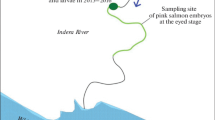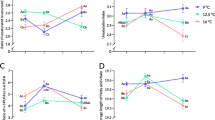Abstract
Lipid and fatty acid modifications induced by the effects of various salinity patterns on the juvenile pink salmon Oncorhynchus gorbuscha (the Olkhovka River and the White Sea) within the experiment have been revealed. Concentrations of steroids, saturated fatty acids, and signaling molecules such as phospholipids (phosphatidylserine and phosphatidylinositol) and arachidonic acid under the hyperosmotic stress-related effects (keeping the fish for 1 h in the seawater after the time of transfer from the freswater) tend to increase. Decreases in phosphatidylcholine and n-6 saturated, monounsaturated, and polyunsaturated fatty acids are recorded in the juvenile pink salmon fish kept for 24 h in the seawater after the time of transfer them from the freswater, while the levels of phosphatidylethanolamine and n-3 polyunsaturated fatty acids (especially eicosapentaenoic and docosahexaenoic acids), on the contrary, tend to rise significantly. Lipid composition modifications in the juvenile pink salmon fish kept under the hypoosmotic stress conditions (24 h in freshwater after 24 h in seawater) induce stabilization of functioning the cell membrane structure, since the levels of bioeffectors including phosphatidylserine, phosphatidylinositol, and arachidonic, eicosapentaenoic, and docosahexaenoic acids tend to decrease. A reduced amount of lipids (triacylglycerols) stored as an energy reserve is shown for all the experimental fish groups. The outcomes indicate the high levels of adaptive potential of the juvenile pink salmon fish kept under the effects of abrupt salinity change in the water environments and their readiness for downstream migration not long before leaving the nests.

Similar content being viewed by others
REFERENCES
Allen, P.J., McEnroe, M., Forostyan, T., et al., Ontogeny of salinity tolerance and evidence for seawater-entry preparation in juvenile green sturgeon, Acipenser medirostris, J. Comp. Physiol. B, 2011, vol. 181, no. 8, pp. 1045–1062. https://doi.org/10.1007/s00360-011-0592-0
Arjona, F.J., Vargas-Chacoff, L., and Ruiz-Jarabo, I., Osmoregulatory response of Senegalese sole (Solea senegalensis, Kaup 1858) to changes in environmental salinity, Comp. Biochem. Physiol. A, 2007, vol. 148, no. 2, pp. 413–421. https://doi.org/10.1016/j.cbpa.2007.05.026
Babili, M.E., Brichon, G., and Zwingelstein, G., Sphingomyelin metabolism is linked to salt transport in the gills of euryhaline fish, Lipids, 1996, vol. 31, no. 4, pp. 385–392. https://doi.org/10.1007/BF02522924
Bell, J.G., Tocher, D.R., Farndale, B.M., et al., The effect of dietary lipid on polyunsaturated fatty acid metabolism in Atlantic salmon (Salmo salar) undergoing parr-smolt transformation, Ibid., 1997, vol. 32, no. 5, pp. 515–525. https://doi.org/10.1007/s11745-997-0066-4
Bogdanov, M. and Doukhan, V., Lipid-mediated protein folding, Zh. Biol. Khim., 1999, vol. 274, pp. 827–830.
Daikoku, T., Yano, I., and Masuf, M., Lipid and fatty acid composition and their changes in the different organs and tissues of guppy Poecilia reticulata on sea water adaptation, Comp. Biochem. Physiol. A, 1982, vol. 73, no. 2, pp. 167–174. https://doi.org/10.1016/0300-9629(82)90050-0
Eliseeva, I.I., Statistika (Statistics), Moscow: Vyssh. Obrazovanie, 2007.
Engelbrecht, F.M., Mari, F., and Anderson, J.T., Cholesterol determination in serum. A rapid direction method, S. Afr. Med. J., 1974, vol. 48, no. 2, pp. 250–256.
Folch, J., Lees, M., and Stanley, G.H.S., A simple method for the isolation and purification of total lipides from animal tissues, J. Biol. Chem., 1957, vol. 226, no. 1, pp. 497–509. https://doi.org/10.1016/S0021-9258(18)64849-5
Folmar, L.C. and Dickhoff, W.W., The parr-smolt transformation (smoltification) and seawater adaptation in salmonids, Aquaculture, 1980, vol. 21, no. 1, pp. 1–37. https://doi.org/10.1016/0044-8486(80)90123-4
Guidelines for the Use of Fishes in Research, Bethesda: Am. Fish. Soc., 2014.
Handeland, S.O., Bjornsson, B.T., Arnesen, A.M., and Stefansson, S.O., Seawater adaptation and growth of post-smolt Atlantic salmon (Salmo salar) of wild and fanned strains, Aquaculture, 2003, vol. 220, nos. 1–4, pp. 367–384. https://doi.org/10.1016/S0044-8486(02)00508-2
Hansen, H.J.M., Kelly, S.P., Grosell, M., and Wood, C.M., Studies on lipid metabolism in trout (Oncorhynchus mykiss) branchial cultures, J. Exp. Zool., 2002, vol. 293, no. 7, pp. 683–692. https://doi.org/10.1002/jez.10166
Harel, M., Gavasso, S., Leshin, J., et al., The effect of tissue docosahexaenoic and arachidonic acids levels on hypersaline tolerance and leucocyte composition in striped bass (Morone saxatilis) larvae, Fish Physiol. Biochem., 2001, vol. 24, no. 2, pp. 113–123. https://doi.org/10.1023/A:1011924704459
Herrera, M., Vargas-Chacoff, L., Hachero, I., et al., Osmoregulatory changes in wedge sole (Dicologoglossa cuneata, Moreau, 1881) after acclimation to different environmental salinities, Aquac. Res., 2009, vol. 40, no. 7, pp. 762–771. https://doi.org/10.1111/j.1365-2109.2008.02147.x
Hochachka, P.W. and Somero, G.N., Biochemical Adaptation: Mechanism and Process in Physiological Evolution, New York: Oxford Univ. Press, 2002.
Hunt, A.O., Oxkan, F.E., Engin, K., and Tekelioglu, N., The effects of freshwater rearing on the whole body and muscle tissue fatty acid profile of the European sea bass (Dicentrarchus labrax), Aquacult. Int., 2011, vol. 19, no. 1, pp. 51–61. https://doi.org/10.1007/s10499-010-9340-9
Jamieson, G.R., GLS identification techniques for long-chain unsaturated fatty acids, J. Chromatogr. Sci., 1975, vol. 13, no. 10, pp. 491–497. https://doi.org/10.1093/chromsci/13.10.491
Jana, L., Huang, X., Zhang, L., and Zhuang, P Hematological parameters of Amur sturgeon, Acipenser schrencki, during different salinity domestication, Mar. Fish, 2006, vol. 28, pp. 177–184.
Kreps, E.M., Lipidy kletochnykh membran (Cell Membrane Lipids), Leningrad: Nauka, 1981.
Kültz, D., Physiological mechanisms used by fish to cope with salinity stress, J. Exp. Biol., 2015, vol. 218, no. 12, pp. 1907–1914. https://doi.org/10.1242/jeb.118695
Li, H.-O. and Yamada, J., Changes of the fatty acid composition in smolts of Masu salmon (Oncorhynchus masou), associated with desmoltification and seawater transfer, Comp. Biochem. Physiol. A, 1992, vol. 103, no. 1, pp. 221–226. https://doi.org/10.1016/0300-9629(92)90266-S
Li, S., He, F., Wen, H., et al., Low salinity affects cellularity, DNA methylation, and mRNA expression of igf1 in the liver of half smooth tongue sole (Cynoglossus semilaevis), Fish Physiol. Biochem., 2017, vol. 43, no. 6, pp. 1587–1602. https://doi.org/10.1007/s10695-017-0395-7
Logue, J.A., Howell, B.R., Bell, J.G., and Cossins, A.R., Dietary n-3 long-chain polyunsaturated fatty acid deprivation, tissue lipid composition, ex vivo prostaglandin production, and stress tolerance in juvenile Dover sole (Solea solea L.), Lipids, 2000, vol. 35, no. 7, pp. 745–755. https://doi.org/10.1007/s11745-000-0581-3
Mancera, J.M. and McCormick, S.D., Role of prolactin, growth hormone, insuline-like growth factor and cortisol in teleost osmoregulation, in Fish Osmoregulation, New York: Sci. Pub., 2007, pp. 497–515. https://doi.org/10.1201/9780429063909
Marshall, W.S., Na+, Cl−, Ca2+ and Zn2+ transport by fish gills: Retrospective review and prospective synthesis, J. Exp. Zool., 2002, vol. 292, no. 3, pp. 264–293. https://doi.org/10.1002/jez.10127
Martins, Y.S., Melo, R.M.C., Campos-Junior, P.H.A., et al., Salinity and temperature variations reflecting on cellular PCNA, IGF-I and II expressions, body growth and muscle cellularity of a freshwater fish larvae, Gen. Comp. Endocrinol., 2014, vol. 202, pp. 50–58. https://doi.org/10.1016/j.ygcen.2014.03.047
McKenzie, D.J., Cataldi, E., Romano, P., et al., Effects of acclimation to brackish water on tolerance of salinity challenge by young-of-the-year Adriatic sturgeon (Acipenser naccarii), Can. J. Fish. Aquat. Sci., 2001, vol. 58, no. 6, pp. 1113–1121. https://doi.org/10.1139/f01-058
Mustafa, T. and Srivastava, K.C., Prostaglandins (eicosanoids) and their role in ectothermic organisms, Adv. Comp. Environ. Physiol., 1989, vol. 5, pp. 157–207. https://doi.org/10.1007/978-3-642-74510-2_6
Nemova, N.N., Kaivarainen, E.I., Rendakov, N.L., et al., Cortisol content and Na+/K+-ATPase activity under adaptation of juvenile pink salmon Oncorhynchus gorbuscha (Salmonidae) to salinity changes, J. Ichthyol., 2021, vol. 61, no 5, pp. 771–778. https://doi.org/10.1134/S0032945221050118
Robertson, J.C. and Hazel, J.R., Influence of temperature and membrane lipid composition on the osmotic water permeability of teleost gills, Physiol. Biochem. Zool., 1999, vol. 72, no. 5, pp. 623–632. https://doi.org/10.1086/316699
Sangiao-Alvarellos, S., Arjona, F.J., and Martín del Río, M.P., Time course of osmoregulatory and metabolic changes during osmotic acclimation in Sparus auratus, J. Exp. Biol., 2005, vol. 208, no. 22, pp. 4291–4304. https://doi.org/10.1242/jeb.01900
Sarkheil, M., Sorki, M.P., and Raefipour, H., Effects of acclimation to seawater salinity on some blood parameters in wild Caspian brown trout, Salmo trutta caspius, Comp. Clin. Pathol., 2017, vol. 26, no. 6, pp. 1315–1318. https://doi.org/10.1007/s00580-017-2531-2
Shtal’, E., Khromatografiya v tonkikh sloyakh (Chromatography in Thin Layers), Moscow: Mir, 1965.
Si, Y., Wen, H., Li, Y., et al., Liver transcriptome analysis reveals extensive transcriptional plasticity during acclimation to low salinity in Cynoglossus semilaevis, BMC Genomics, 2018, vol. 19, Article 464. https://doi.org/10.1186/s12864-018-4825-4
Sidorov, V.S., Lizenko, E.I., Bolgova, O.M., and Nefedova, Z.A., Fish lipids. 1. Methods of analysis. Tissue specificity of vendace Coregonus albula L., in Lososevye (Salmonidae) Karelii (Salmon Fishes (Salmonidae) of Karelia), Petrozavodsk: Karel. Fil. Akad. Nauk SSSR, 1972, pp. 152–163.
Soengas, J.L., Sangiao-Alvarellos, S., Laiz-Carrio’n, R., and Mancera, J.M., Energy metabolism and osmotic acclimation in teleost fish, in Fish Osmoregulation, New York: Sci. Pub., 2007, pp. 277–308. https://doi.org/10.1201/9780429063909
Tocher, D.R. and Sargent, J.R., The effects of calcium ionophore A23187 on the metabolism of arachidonic and eicosapentaenoic acids in neutrophils from a marine teleost fish rich in (n-3) polyunsaturated fatty acids, Comp. Biochem. Physiol. B, 1987, vol. 87, no. 4, pp. 733–739. https://doi.org/10.1016/0305-0491(87)90381-6
Tocher, D.R., Castell, J.D., Dick, J.R., and Sargent, J.R., Effects of salinity on the fatty acid compositions of total lipid and individual glycerophospholipid classes of Atlantic salmon (Salmo salar) and turbot (Scophthalmus maximus) cells in culture, Fish Physiol. Biochem., 1995, vol. 14, no. 2, pp. 125–137. https://doi.org/10.1007/BF00002456
Tocher, D.R., Bendiksen, E.A., Campbell, P.J., and Bell, J.G., The role of phospholipids in nutrition and metabolism of teleost fish, Aquaculture, 2008, vol. 280, nos. 1–4, pp. 21–34. https://doi.org/10.1016/j.aquaculture.2008.04.034
Tsyganov, E.P., Method of direct lipid methylation after TLC without elution from silica gel, Lab. Delo, 1971, no. 8, pp. 490-493.
Vargas-Chacoff, L., Saavedra, E., Oyarzun, R., et al., Effects on the metabolism, growth, digestive capacity and osmoregulation of juvenile of Sub-Antarctic Notothenioid fish Eleginops maclovinus acclimated at different salinities, Fish Physiol. Biochem., 2015, vol. 41, no. 6, pp. 1369–1381. https://doi.org/10.1007/s10695-015-0092-3
Wedermeyer, G.A., Saunders, R.L., and Clarke, W.C., Environmental factors affecting smoltification and early marine survival of Anadromous Salmonids, Mar. Fish. Rev., 1980, vol. 42, no. 6, pp. 1–14.
Zwingelstein, G. and Bodennec, J., Phospholipid metabolism in euryhaline fish and crustaceans. Effects of environmental salinity and temperature, Recent Res. Dev. Lipids Res., 1998, vol. 2, pp. 39–52.
Funding
The research survey was carried out with a financial support of State Task FMEN-2022-0006 (State Registration no. 122032100052-8) for Institute of Biology, Karelian Research Center, Russian Academy of Sciences
Author information
Authors and Affiliations
Corresponding author
Ethics declarations
Conflict of interests. The authors declare that they have no conflicts of interest.
Statement on the welfare of animals. All applicable international, national, and/or institutional guidelines for the care and use of animals were followed.
Additional information
Translated by O. Zhiryakova
Rights and permissions
About this article
Cite this article
Vasileva, O.B., Efremov, D.A., Ruokolainen, T.R. et al. Effects of Salinity on Lipid Composition in Juvenile Pinc Salmon Oncorhynchus gorbuscha (Salmonidae). J. Ichthyol. 63, 591–597 (2023). https://doi.org/10.1134/S0032945223030165
Received:
Revised:
Accepted:
Published:
Issue Date:
DOI: https://doi.org/10.1134/S0032945223030165




